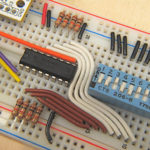The Global Positioning System, better known as GPS, is a satellite-based navigation system that lets users determine the precise location and track movement anywhere on Earth. The system consists of a network of satellites orbiting the Earth, ground stations, and receivers. To learn more about GPS, click here.
It’s possible to build a basic GPS for personal or educational purposes. You’ll need one of the below ICs/modules for your tracking system, which must be supported by GNSS constellations and an energy source.
GPS tracking ICs
Here are some of the top-ranked GPS tracking ICs/modules for building GPS receivers.
- u-blox ZED-F9P GNSS Module
- MTK MT3333 GNSS Module
- Quectel L76-LB GNSS Module
- SimCom SIM808 GNSS Module
- Nordic nRF9160 SiP
- u-blox MAX-M8Q GNSS Module
- Telit LE910C1-GL
- MediaTek MT3339 GNSS Module
- Sierra Wireless BC350
- MaxLinear G702 GNSS Module
u-blox ZED-F9P GNSS is a high-precision positioning module designed and manufactured by u-blox, a Swiss company specializing in positioning and wireless communication technologies. The module is known for its advanced features and capabilities, providing accurate and reliable positioning information. It supports multiple global navigation satellite systems, including GPS, GLONASS, Galileo, BeiDou, and QZSS.
This multi-constellation support enhances positioning accuracy and reliability, particularly in challenging environments. It’s designed for high-precision positioning applications and is compatible with Real-Time Kinematic (RTK) positioning. This method uses reference station correction data to improve GNSS location accuracy.
With RTK and Precise Point Positioning (PPP), the u-blox module can provide centimeter-level accuracy and has additional sensors (such as accelerometers and gyroscopes), contributing to improved reliability, especially when the GNSS signal is temporarily lost. The module provides standard communication interfaces, such as UART (serial), SPI, I2C, and USB, for communication with a microcontroller.
With a programmable flash memory, the settings and functionalities of the module can be tailored to specific needs. The module can be used in various applications, including robotics, autonomous vehicles, personal tracking, precision agriculture, surveying and mapping, marine navigation, and others where precise positioning is required.
The MTK MT3333 (available at DigiKey) is a GNSS module developed by MediaTek, a Taiwanese semiconductor company. It supports multiple global navigation satellite systems, including GPS, GLONASS, Beidou, and Galileo. A high tracking sensitivity of -165dBm makes the module suitable for environments with challenging signal conditions, such as urban canyons or dense foliage. It also supports Assisted-GNSS technology, which uses additional data from external servers to enhance the speed and accuracy of satellite signal acquisition. It features Fast Time to First Fix (TTFF), useful for accurate positioning within seconds.
The MT3333 is based on the ARM7EJ-S CPU and comprises an on-chip CMOS RF, a digital baseband, and an embedded NOR flash. It can be easily integrated with any microcontroller through UART, SPI, or I2C. Available in a QFN package, the module is compact and designed for low-power consumption. The module best suits applications like personal navigation, asset tracking, drones, robotics, vehicle tracking, and location-based services.
Quectel L76-LB GNSS is a GNSS module manufactured by Quectel that supports multiple global navigation satellite systems, including GPS, GLONASS, and BeiDou. It features 99 acquisition and 33 tracking channels. It also supports Assisted-GNSS technology and may have integrated Real-Time Clock in some breakout boards. The module typically requires an external antenna for optimal performance and supports several GNSS antennas.
L76-LB features a cold start time of 32 seconds, a warm start of two seconds, and a hot start of one second. The IC features serial interfaces like UART and USB for interfacing with a microcontroller. Quectel L76-LB is a low-power, compact GPS receiver suitable for real-time tracking and location-based services that’s available at DigiKey.
The SimCom SIM8080 is a multi-functional module manufactured by Shenzhen Simcom Electronics that integrates GSM/GPRS, GPS, and Bluetooth functionalities. It also supports GPS and GLONASS constellations. The GPS chip features 22 tracking channels and 66 acquisition channels.
SIM8080 is a low-power, compact (19.0 x 24.0 x 2.6mm in dimensions), and low-cost GPS module suitable for applications requiring basic GNSS functionality at an affordable price. It features a cold start time of 32 seconds, a warm start of 22 seconds, and a hot start of one second.
The L76-LB is smaller in size compared to the SIM808. Also, the u-blox ZED-F9P delivers significantly higher accuracy and multi-band support, and the MTK MT3333 offers multi-constellation support (GPS, GLONASS, Galileo, BeiDou) for improved signal acquisition. SIM808 is best suited for budget-constraint projects requiring low-cost real-time tracking.
The Nordic nRF9160 SiP (System-in-Package) is a high-performance, low-power cellular (Internet of Things (IoT) module developed by Nordic Semiconductor, a Norwegian semiconductor company known for its wireless communication solutions. The module includes an integrated LTE-M/NB-IoT modem, enabling wide-area (LPWA) cellular connectivity. It combines the powerful Arm Cortex-M33 processor with a multi-band LTE-M/NB-IoT cellular modem and a GNSS receiver (GPS, GLONASS, Galileo, BeiDou).
With support for various cellular network bands, the nRF9160 guarantees global connectivity, offering excellent signal penetration and range. The module comes in a small form factor (10.4 x 10.4 x 1.4mm) and features built-in security through hardware encryption and secure boot. Nordic provides comprehensive software development kits (SDKs) and module tools, simplifying the development and accelerating time-to-market. It’s available for an affordable price at DigiKey.
The u-blox MAX-M8Q is a popular and versatile GNSS module manufactured by u-blox. It’s part of u-blox’s M8 series, known for its high-precision positioning capabilities. The module supports GPS, GLONASS, Galileo, and BeiDou constellations for global coverage and reliable signal acquisition. It features a high sensitivity of -165 dBm for accurate positioning even in weak signal environments.
The module is compact (9.7 x 10.1 x 5.4mm) and has low power consumption. It can be easily integrated with any microcontroller through UART, SPI, or I2C interfaces. Some of the advanced features of u-blox MAX-M8Q include Fast Time to First Fix (TTFF) for quick acquisition of satellite signals, AssistNow for faster initial fix, built-in flash memory for storing configuration settings and firmware updates, and dead reckoning for maintaining position during signal loss.
The u-blox MAX-M8Q GNSS Module is a well-rounded option for applications requiring good accuracy, versatility, and affordability. It suits real-time tracking, personal navigation, mapping, vehicle tracking, and asset-tracking applications.
The Telit LE910C1-GL is a mid-range LTE Cat 1 GNSS module designed for basic location and data communication needs and manufactured by Telit. This Italian company specializes in wireless communication modules for the IoT and machine-to-machine (M2M) applications.
The x LE910C1-GL is part of Telit’s xE910 family, which includes a variety of modules supporting different cellular technologies. This module supports GPS, GLONASS, Galileo, and BeiDou constellations for global positioning and provides cellular connectivity through LTE Cat 1 technology with fallback to 2G networks (GPRS/EDGE). It also includes an embedded TCP/IP stack, facilitating internet data communication.
LE910C1-GL is a low-power, compact chip. It offers location accuracy down to 2.5 meters (95% CEP). It offers UART, I2C, and SPI interfaces for communication with a microcontroller. Its security features include secure boot and hardware encryption. The supported Internet data rates are 10 Mbps for downlink and 5 Mbps for uplink. The LE910C1-GL also features AssistNow for faster initial fix and dead reckoning for position maintenance during signal loss.
The MediaTek MT3339 is a high-performance single-chip, multi-GNSS module that provides accurate positioning and navigation capabilities — primarily for applications such as automotive navigation, outdoor sports, and various location-based services. It supports multiple global navigation satellite systems, including GPS, GLONASS, and QZSS.
With a high sensitivity of -165 dBm, the MT3339 offers accurate positioning in challenging environments like urban canyons or dense foliage. The module typically requires an external antenna for optimal GNSS performance. The IC comes in a compact form factor (12 x 12 x 6.5mm) and features a built-in 12 multi-tone active interference canceller, AssistNow, and dead reckoning.
The Sierra Wireless BC350 is a mid-range GNSS module that supports GPS, GLONASS, Galileo, and BeiDou constellations for positioning. It offers a moderate sensitivity of -148 dBm, which is suitable for many applications. The module features built-in Assisted GNSS (A-GNSS), WAAS/EGNOS, satellite blocklisting, and Dead Reckoning. The module is compact (19.0 x 24.0 x 2.6mm) and has low power consumption. The module’s Time to First Fix (TTFF) is two to three seconds, depending upon the conditions. The module is suitable for basic location awareness without needing high-precision accuracy.
The MaxLinear G702 is a mid-range GNSS module that supports GPS, GLONASS, and BeiDou constellations. It offers a moderate sensitivity of -148 dBm, which is suitable for many applications. The module features built-in Assisted GNSS (A-GNSS), WAAS/EGNOS, satellite blacklisting, and Dead Reckoning. The module comes in a compact form factor (19.0 x 19.0 x 2.5mm) and is designed for low-power consumption. The module’s Time to First Fix (TTFF) is two to three seconds, depending upon the conditions. It’s a slightly older module, so its availability and technical support might be limited compared to newer models. The module is only suitable for basic location awareness and moderate accuracy.
You may also like:
Filed Under: Tech Articles


















Questions related to this article?
👉Ask and discuss on Electro-Tech-Online.com and EDAboard.com forums.
Tell Us What You Think!!
You must be logged in to post a comment.